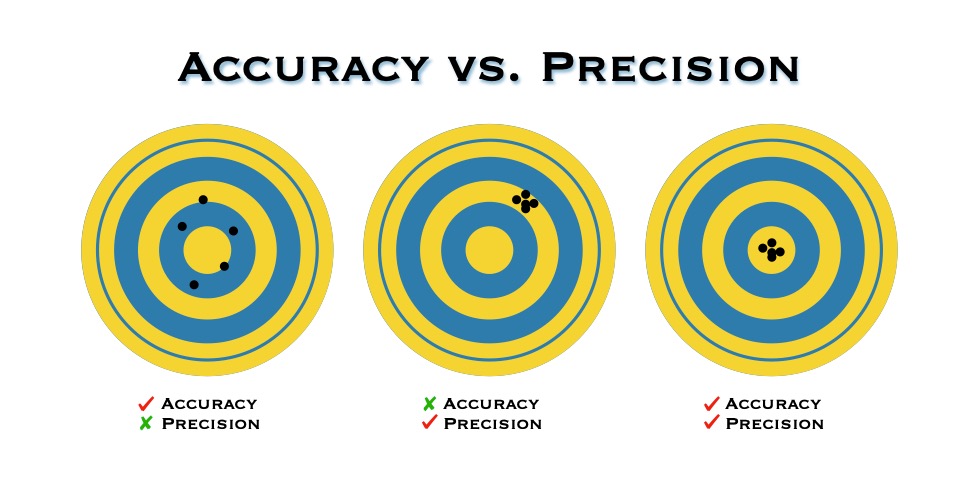There are a number of ways in which you can improve on a rifle’s accuracy and/or precision capability, but first you must understand that accuracy and precision do not have the same meaning. Knowing the difference between the two can be fundamental in developing your skills as a rifle marksman. I have spent many years fine-tuning the accuracy and precision of my rifle systems and ammunition, as well as my own shooting ability in order to ensure the best shooting performance over all distances, and today I am going to share my experience with you. So let’s start off by answering the following question: what is the difference between accuracy and precision, and how can you improve on your rifle’s performance?
ACCURACY – this is defined as the ability to hit your aiming marker. In other words, your grouping (or bullet impact) is equal to your point of aim once accuracy has been achieved, and your bullet is landing exactly where you had planned.
Grouping: otherwise known as a shot grouping or simply a group, this is the pattern of projectile impacts on a target from multiple consecutive shots taken in one shooting session.
PRECISION – this is the rifle’s ability to group well, consistently placing rounds as close together as possible. The tightness of a grouping measures the precision of a weapon, and the shooter’s consistency and skill.

There are many ways in which you can improve the accuracy potential and precision of your weapon system, from handloading custom ammunition, to upgrading parts and accessories, and making use of proper support techniques. These methods will be discussed in more detail throughout this blog.
So How Can You Improve Your Rifle’s Accuracy and/or Precision Potential?
Before going into ways and methods of increasing a rifle’s accuracy potential, it is important to understand that these alterations or modifications won’t necessarily improve the inherent accuracy, but will rather promote accuracy, making it easier to achieve. In other words, a highly experienced shooter is often able to shoot a standard factory rifle with good or even great accuracy, but a number of things can be done to the rifle to improve accuracy in the hands of a shooter who is less experienced.
When it comes to precision however, there are steps that can be taken which will actually increase precision, giving you a rifle system that shoots tighter groups than what was previously possible.
1. A Stable (No Wobble) Support System
Some common methods of rifle support which are used to promote accuracy include the sandbag, benchrest and bipod.

- Sandbag – when used correctly, the sandbag provides a firm, movement-free support platform which is arguably one of the best methods of practically supporting a rifle. The downside is that they are heavy and cumbersome to lug around.
- Benchrest – providing extremely precise accuracy potential, the benchrest support system is mechanical, non-portable (to a degree), and is most often used by competitors who require high-precision to engage paper targets. I personally stay away from these support systems as they are not practical under field conditions.
- Bipod – one of the most popular and widely used portable support platforms, the bipod is an excellent lightweight accessory. It must however be of high quality, sturdy, and able to pivot while preventing both lateral and vertical movement when squeezing the trigger.
2. The Sand [or Rice] Sock

When firing prone, a sand sock, rice sock, or rear bag can be placed beneath the butt of the rifle. This creates a heavy and stable rear rest, promoting accuracy.
When doing so, turn the non- shooting hand back under the butt, supporting the sock/bag while simultaneously holding the butt firmly into the shoulder. A slight squeeze or release of the sock/bag will assist in adjusting the crosshair’s vertical alignment, keeping a stable aim.
3. A Crisp, Precision Trigger
A good, clean-breaking trigger is important, and is often non-standard on mass-produced rifles.
The trigger is the primary point of contact between the rifle and the shooter, and improving the performance and consistency of your trigger is considered to be one of the most important modifications you can make (if required), particularly when firing from unconventional firing positions.
Heavy, gritty, inconsistent triggers interfere with clean shot execution. No matter how perfect your position, sight picture, and technique, practical shots from field positions unavoidably suffer from a poor trigger.
Rifleshootermag.com
4. Silencers and Muzzle Brakes
Two of the greatest advantages of silencers (or sound suppressors) and muzzle brakes are their ability to substantially reduce felt recoil and jump angle, creating a more enjoyable shooting experience while simultaneously promoting accuracy.

While they don’t do much in terms of precision, you’ll certainly notice an improvement in placing your bullet where intended, specifically when shooting from alternate firing positions or between various support systems. If you have not yet explored the advantages of using a sound suppressor, then come back and give the following article a read: What are the Advantages of using a Rifle Suppressor [or Silencer]?
5. Bedding The Action
The term bedding refers to the fit and stability of a barrelled action within the rifle stock. Bedding is most often an aftermarket improvement made by an experienced gunsmith to a rifle stock, with the aim of increasing precision and extending its lifespan.
The bedding process creates a stable and flush surface between the stock and the rifle’s action (or receiver), preventing any distortion or shifting that may otherwise be caused by the rifle’s recoil, resulting in a loss of precision. This process is not needed when using a tactical chassis.
6. The Aftermarket Stock or Chassis System
A good quality stock or chassis is often thought of as the foundation for precision shooting and accuracy, serving as a physical interface between the shooter and the rifle.
Stocks are made from a variety of materials from wood, to kevlar, fibreglass and even carbon fibre, while the chassis is most often constructed of aluminium, avoiding the need for bedding in their design.

Whether you choose an aftermarket stock or chassis, it should be adjustable at the butt and cheek-rest, as this is where your body will make the most contact with your rifle. Adjustable length and height will aid in a consistent eye relief, sight alignment, and spot- weld, with the most efficient recoil absorption.
7. Modern Scope [and Mount] Features
Gone are the days of the plain-crosshair reticle and capped turrets, at least when mid to long range accuracy is to be desired. The innovations made by modern scope manufacturers have introduced shooters to a new world of accuracy potential and precision capability.
Aim to always buy high quality optics from reputable manufacturers, and consider modern reticles and adjustable turrets which allow for precise adjustments to your bullet’s trajectory. The following blog will help you out if you’re looking for a new scope: How to Choose a Rifle Scope.
Invest in a good mounting system as well, as cheap mounts are often stamped from soft alloys which are not capable of managing the recoil produced by high-powered rifles, causing these mounts to slowly shake loose and shift the rifle’s zero.
8. Scope Use & Recommended Accessories
Consider the following scope-related tips when trying to tighten up your grouping or achieve consistent accuracy:
- Set Your Parallax – most high quality variable zoom scopes have an adjustment for parallax. An incorrect parallax setting will most likely result in a different point of impact from the scope’s zero, providing a similar result to firing a rifle with only a front iron sight (the rear sight missing), but not as extreme. It is important to understand how to correctly set the parallax on your scope for each range, and then remember to make the adjustment before firing, otherwise accuracy may be lost.
- Level That Scope – A bubble level for your scope is considered to be an essential item when you intend on shooting over medium to longer distances. Without one, you are very likely to experience an inconsistent horizontal displacement of your bullet in relation to your point of aim, destroying accuracy. This is known as cant error.
- Don’t Over-Magnify – it is always nice to have a scope with a high magnification capability, but too many shooters get caught in the habit of using the maximum setting at all times. There are a few disadvantages to shooting on max magnification, one of which causes your target to move or distort when mirage is present. This will diminish accuracy, and as a rule of thumb, I recommend using the least magnification that gives you a clear and comfortable view of your target at each distance.
- The Lens Hood – using a lens hood can help prevent glare from the sun, but more importantly, it keeps rain off of the objective lens and allows for a much clearer image when observing your target in poor weather conditions.
9. Finding That Node Through Load Development
Pairing a good accurate bullet with a rifle’s barrel is integral in achieving precision. This process often involves custom-loaded ammunition which is specifically developed for your own rifle, as you cannot guarantee that factory ammo will produce the desired precision.
In order to understand why this process is so vital, you must first understand that each and every rifle barrel develops its own unique set of vibrations when a cartridge is fired. These vibrations are known as barrel harmonics. Depending on how a barrel reacts to a cartridge’s explosive power and vibrational effects, will depend on how much movement the muzzle experiences. This muzzle movement needs to be reduced as much as possible by finding a series of ideal velocity ranges for your barrel, which are commonly referred to as “harmonic nodes” or “sweet spots”.
Finding your barrel’s node and therefore its most precise grouping capability is achieving by developing the perfect cartridge load; selecting a high quality bullet which is seated into the cartridge to a specifically chosen overall length with just the right amount of propellant. The process is known as load development.
To Cap It All Off…
I hope you have enjoyed this blog as learnt something from it. If so, please share and leave us a comment below. And if you are a shooter who regularly enjoys pushing your rifle to its limits and aiming to hit those long range gongs, then I’d highly recommend reading the following article: 10 Steps to Improving Long Range Shooting [and Consistency]


One thought on “9 Ways To Increase Your Rifle’s Accuracy and Precision”
Valuable information, but when you getting older your eyesight become more unclear, and you get a unnessary shivering. But still I enjoy it to shoot my rifles. Thanks anyway!!!